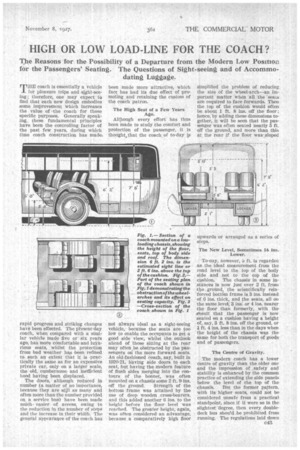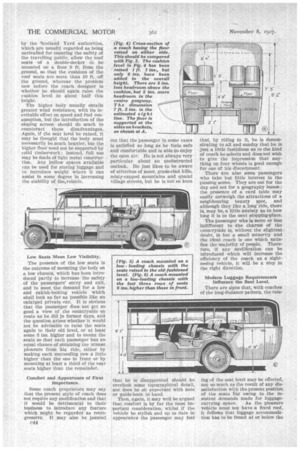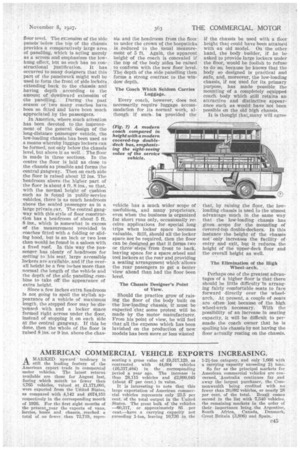HIGH OR LOW LOAD-LINE FOR THE COACH?
Page 101

Page 102

Page 103

If you've noticed an error in this article please click here to report it so we can fix it.
The Reasons for the Possibility of a Departure from the Modern Low Position fOr the Passengers' Seating. The Questions of Sight-seeing and of Accommodating Luggage.
THE coach is essentially a vehicle for pleasure trips and sjght-seeing ; therefore, one may expect tu find that each new design embodies some improvement which increases the value of the coach for those specific purposes. Generally speaking, these fundamental principles have been the controlling factor of the past few years, during which time coach construction has ruade
rapid 'progress and striking changes have been effected. The PFesentday coach, when compared with a similar vehicle Made five or six years ago, has more cOmfortable and luxurious seats, whilst the protection from bad weather has been refined to such an extent that it is .practically the same as for an expensive private car, only on a larger scale, the old, cumbersome and inefficient hood having been displaced.
The doors, although reduced in number (a matter of no importance, because they are sti,11 as many and often more than-the number provided on a service bus) have been made much, easier of access, owing to the reduction in the number of steps and the increase in their width. The general appearance of the coach has
been made more attractive, which fact has had its due effect of promoting and retaining the custom of the coach patron.
The High Seat of a Few Years Ago.
Although every effort has thus been made to study the comfort and protection of the passenger, it is thought, that •the coach. of to-day not always ideal as a sight-seeing vehicle, because the seats are too low to enable the occupants to get a good .side view, whilst the outlook ahead of those sitting at the rear may often be obstructed by the passengers on the more forward seats. An old-fashioned coach, say, built in 1920-21, having side doors to each seat, but having the modern feature of flush sides merging into the contours of the bonnet, was often mounted on a chassis some 2 ft. 9 ins.
off the ground. Strength of the bottom frame was attained by the use of deep wooden cross-hearers, and this added another 6 ins, to the height before the floor level was reached. The greater height, again, was often considered an Advantage, because, a comparatively high floor
simplified the problem of reducing the size of the wheel-arch—an important matter 'when all the 'seats are required to face forwards. Then the top of the cushion would often be about 1 ft. 8 ins. off the floor ; hence, by adding these dimensions together, it will be seen that the passenger was often seated nearly 5 ft. off the ground, and more• than this at the rear if the floor was:sloped
upwards or arranged as a series of steps.
The New Level, Sometimes 16 ins. Lower.
• To-oay, nowever, 5 ft. is regarded as the ideal measurement from the road level to the top of the body side and not to the' top of the cushion. The chassis in some in'stances is now just over 2 ft. from the ground, the scientifically reinforced bottom frame is 3 ins. instead of 6 ins, thick, and the seats, all on the same level; Sins: or 4 ins, nearer the floor than formerly, with the :result that the passenger is now seated on a cushion having a height of, say, 3 ft. 8 ins, off the ground, Or 1 ft. 4 ins, less than in the days when the height of the chassis was the same for both the transport of goods and of passengers.
The Centre of Gravity.
The modern coach has a lower centre of gravity than the older one and the impression of safety and stability is enhanced by the common practice of extending the side panels below the level of the top of the
chassis. But the former pattern, with its higher seats, could not be considered unsafe from a practical standpoint, since if if were so in the slightest degree, then every doubledeck bus should be prohibited from running. The regulations laid down
by the Scotland Yard authorities, which are usually regarded as being unrivalled for ensuring the safety of the travelling public, allow the roof seats -of a double-decker to be mounted on a floor 9 ft. frdm the ground, so that the cushions of the roof seats are more than 10 ft. off the ground, whereas the problem now before the coach designer is whether he should again raise the cushion level to about half this height.
The higher body usually entails greater wind resistance, with its inevitable effect on speed and fuel consumption, but the introduction of the sloping screen should do much to counteract these disadvantages. Again, if the seat level be raised, it may be thought that the body must necessarily, be much heavier, but the higher floor need not be supported by solid timberwork ; instead, full use may be made of light metal construction. Any bellow spaces available can be used for storing luggage and to introduce weight where it can assist in some degree in increasing the stability of the.,vehicle.
Low Seats Mean Low Visibility.
The presence of the low seats is the outcome of mounting the body on • a low chassis, which has been introduced partly to increase the safety of the passengers' entry and exit, and to meet the demand for a low and rakish-looking vehicle which shall look as far as possible like an enlarged private car. It is obvious that the passenger does not get so good a view of the countryside en route as he did in former days, and the question arises whether it would not be advisable to raise the seats again to their old level, or at least some 6 ins, higher and to mount the seats so that each passenger has an equal chance of obtaining the utmost pleasure from his ride, either by making each succeeding row a little higher than the one in front or by mounting at least a third of the rear seats higher than the remainder.
Comfort and Appearance of First Importance.
Some coach proprietors may say that the present style of coach does not require any modification and that it would be detrimental to their business to introduce any feature which might be regarded as retrogressive. it may also be pointed c44 out that the passenger in some cases is satisfied so long as he feels safe and comfortable and is able to enjoy the open air. He is not always very particular about an unobstructed outlook. He just likes to be aware of stretches of moor, grass-clad hills, misty-capped mountains and quaint village streets, but be is not so keen
that he is disappointed should he overlook some topographical detail, nor does he sit expectant with note or guide-book in hand.
Then, again, it may well be argued that comfort is by far the most important consideration, whilst if the vehicle be stylish and up to date in appearance the passenger may feel that, by riding in it, he is demonstrating to all and sundry that he is just a little fastidious as to the kind of coach he selects and does not wish to give the impression that anything on four wheels is good enough for one of his discernment.
There are also some passengers who take but little interest •in the passing scene. They are out for the day and not for a geography lesson; the presence of a card table may easily outweigh the attractions of a neighbouring beauty spot, and although they like a long'ride, there is, may be, a little anxiety as to how long it is to the next stopping-place.
The passenger who is more or less indifferent to the charms of the countryside is, without the slightest doubt, in but a mall minority and the ideal coach is one which satisfies the majority of people. There-. fore, if any modification can be introduced which will increase the efficiency of the coach as a sightseeing vehicle, it will be a step in the right direction.
jug of the seat level may be effected, not so much as the result of any dissatisfaction with the present position of the seats but owing to the insistent demands., made for luggage carrying space. As the pleasure vehicle must not have a fixed roof, it follows that luggage accommodation has to be found at or below the floor level. The.extensiOn of the side panels' below the top of the chassis provides a comparatively, large area of panelling, which is acting merely as a screen and emphasizes the lowhung effect, but as such has no constructional justification. It has occurred to many designers that this part of the panelwork might well be used to form the front of side lockers extending back to the chassis and having depth according to the amount of downward extension of the panelling. During the past season or two many coaches have been so fitted and have been much appreciated by the passengers.
In America, where much attention has been devoted to the improvement of the general design of the long-distance passenger vehicle, the low-loading chassis has been used as a means whereby luggage lockers can be formed, not only below the chassis level, but above it as well.., The floor is made in three sections. In the centre the floor is laid as close to the chassis as possible and forms the central gangway. Then on each side the floor is raised about 12 ins. The headroom above the higher part, of the floor is about 4 ft. Sins., so that, with the normal height of cushion such as is found in public-service vehicles, there is as much headroom above the seated passenger as in a large private car. The central gangway with this style of floor construction has a headroom of about 5 ft. 8 ins., which is somewhat in excess of the measurement provided in coaches fitted with a folding or sliding hood, but is an inch or two less than would be found in a saloon with a fixed roof. In this way the passenger has plenty of headroom for getting to his seat, large accessible lockers are available, and if the overall height be a few inches more than normal the length of the vehicle and the depth of the side panelling combine to take off the appearance, of extra height.
Since a few inches extra headroom is not going to spOil the stylish appearance of a vehicle of maximum length, the stepped floor may be dis
• pensed, with, and a locker space formed right across under the floor, instead of stopping it on each side at .the central gangway. If this be done, then the whole of the floor is raised 8 ,ins. or 9 ins, above the Chas sis and the headroom from the foot to under the crown of the hoopsticks is reduced to the usual measurement of 5 ft. Again, the apparent height of the coach is concealed if the top of the body sides be raised to conform with the new floor level. The depth of the side panelling then forms a strong contrast to the window depth.
The Coach :Which Seldom Carries Luggage.
Every coach, however, does not necessarily require luggage accommodation for its normal work, although if such, be provided the vehicle has a much wider scope of usefulnes,s, and many proprietors, even when the business is organized for short runs only, occasionally receive applications for special long trips when locker space becomes valuable. Still, should all the locker space not be required, then the floor can be designed so that it forms two or three' steps from front to back, leaving space for a spare :wheel and tool lockers at the rear and providing a seating arrangement which' allows the rear pasengers to get a better view ahead than had the floor been level.
The Chassis Designer's Point of View.
Should the practice grow of raising the floor of the body built on the low-loading chassis, it must be expected 'that some protest will be made by the motor manufacturer. From his point of view, he will feel that alt the expense which has been lavished on the production of new models has been more or less wasted if the chassis be used with a floor height that could have been attained with an old model. On the other hand, the body builder, if he be asked to provide large lockers under the floor, would be foolish to refuse to do so, because he knows tha,t the body so designed is practical and safe, and, moreover, the low-loading chassis, if not used for its primary purpose, has made possible the mounting of a completely equipped coach body which still retains an attractive and distinctive appearance such as would have 'not been possible on the old high chassis.
h is thought that„many will agree that, by raising the floor, the lowloading chassis is used to the utmost advantage much in the same way that the low-loading chassis has given scope for the mounting of covered-top double-deckers. In this instance the height of the chassis not only increases the facility of entry and exit, but it reduces the height of the upper-deck floor and the overall height as well.
The Elimination of the High Wheel-arch.
Perhaps one of the greatest advantages of a higher floor is that there should be little difficulty In arranging fairly comfortable seats to face forward directly over the wheelarch. At present, a couple of seats are often lost because of the high wheel-arch necessary. With the possibility of an increase in seating capacity, it will be difficult to persuade the coach owner that he is spoiling his chassis by not having the floor actually resting on the chassis.




















































































































































































